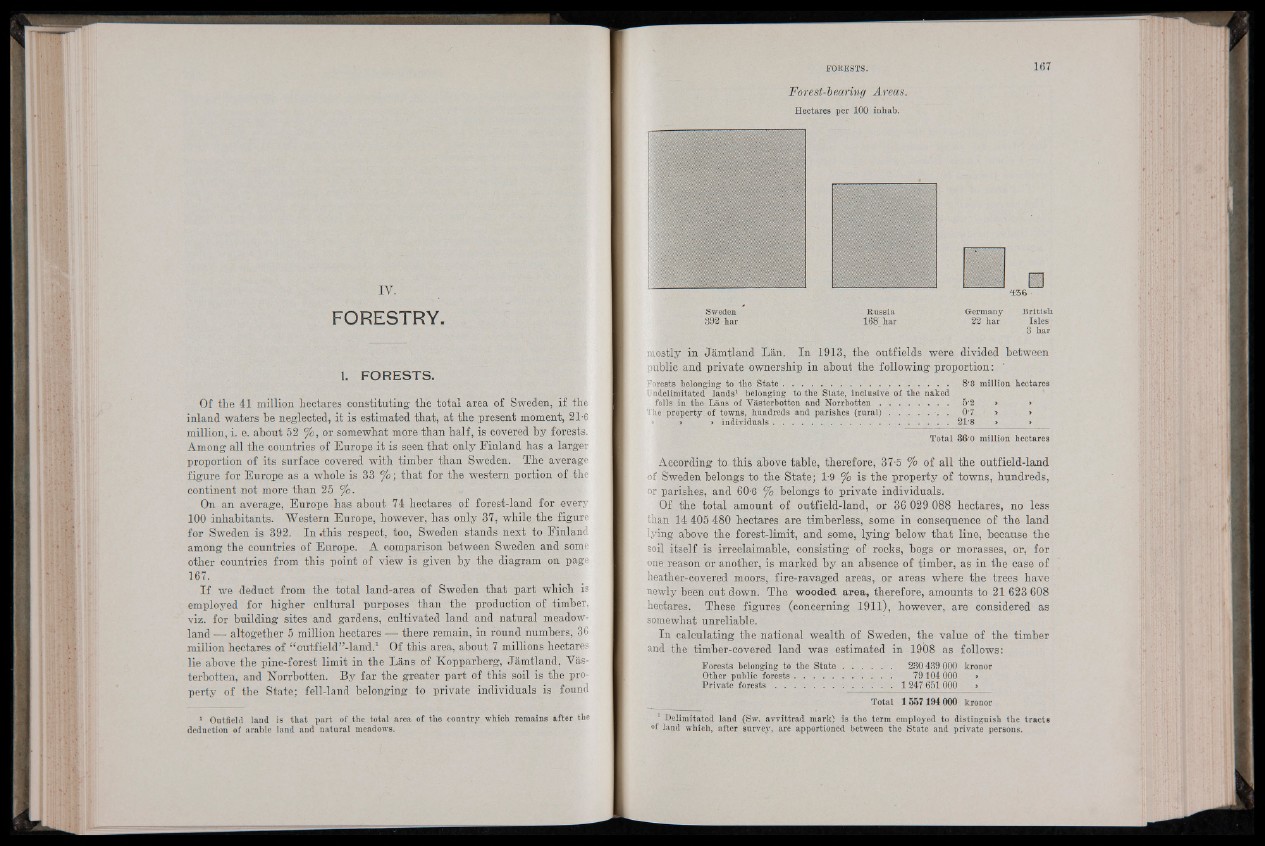
IY .
FORESTRY.
1. FORESTS.
Of the 41 million hectares constituting the total area of Sweden, if the
inland waters be neglected, it is estimated that, at the present moment, 21-6
million, i. e. about 52 %, or somewhat more than half, is covered by forests.
Among all the countries of Europe it is seen that only Finland has a larger
proportion of its surface covered with timber than Sweden. The average
figure for Europe as a whole is 33 %; that for the western portion of the
continent not more than 25 %.
On an average, Europe has about 74 hectares of forest-land for every
100 inhabitants. Western Europe, however, has only 37, while the figure
for Sweden is 392. In .this respect, too, Sweden stands next to Finland
among the countries of Europe. A comparison between Sweden and some
other countries from this point of view is given by the diagram on page
167.
I f we deduct from the total land-area of Sweden that part which is
employed for higher cultural purposes than the production of timber,
viz. for building sites and gardens, cultivated land and natural meadow-
land —■ altogether 5 million hectares — there remain, in round numbers, 36
million hectares of “outfield’Manld.1 Of this area, about 7 millions hectares
lie above the pine-forest limit in the Lans of Kopparberg, Jamtland, Vas-
terbotten, and Norrbotten. By far the greater part of this soil is the property
of the State; fell-land belonging to private individuals is found
i Outfield land is that part of the total area of the conn try which remains after the
deduction of arable land and natural meadows.
Forest-bearing Areas.
Hectares per 100 inhab.
■ ¿£36
British
Isles
3 liar
mostly in Jamtland Lan. In 1913, the outfields were divided between
public and private ownership in about the following proportion:
Forests belonging to the S ta te 8-3 million hectares
Undelimitated lands1 belonging to the State, inclusive of the naked
fells in the Lans of Vasterbotten and N o rrb o tten .............................. 5*2 > >
The property of towns, hundreds and parishes (rural) . . . . . . ■. . 0'7 > >
> > » individuals 21’8 > >
Total 36 0 million hectares
According to this above table, therefore, 37-5 % of all the outfield-land
of Sweden belongs to the State; 1-9 % is the property of towns, hundreds,
or parishes, and 60-6 % belongs to private individuals.
Of the total amount of outfield-land, or 36 029 088 hectares, no less
than 14 405 480 hectares are timberless, some in consequence of the land
lying above the forest-limit, and some, lying below that line, because the
soil itself is irreclaimable, consisting of rocks, bogs or morasses, or, for
one reason or another, is marked by an absence of timber, as in the case of
heather-covered moors, fire-ravaged areas, or areas where the trees have
newly been cut down. The wooded area, therefore, amounts to 21 623 608
hectares. These figures (concerning 1911), however, are considered as
somewhat unreliable.
In calculating the national wealth of Sweden, the value of the timber
and the timber-covered land was estimated in 1908 as follows:
Forests belonging to the S t a t e ...................... 230 439 000 kronor
Other public forests 79 104 000 »
Private f o r e s ts ................................................ 1 247 651 000 >
Total 1557 194 000 kronor
1 Delimitated land (Sw. avvittrad mark) is the term employed to distinguish the tracts
of land which, after survey, are apportioned between the State and private persons.